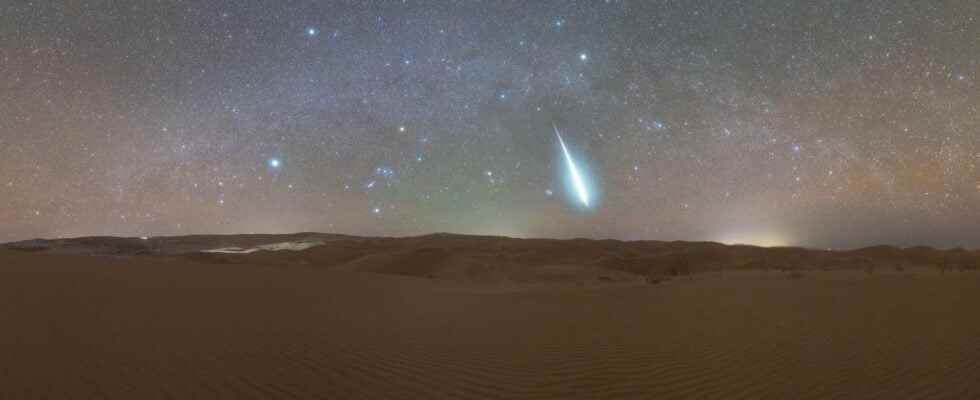If you missed the peak of activity of the Geminids, here are some of the most beautiful photos of the meteor swarm that will convince you to keep an eye out for it every year!
You will also be interested
[EN VIDÉO] Amazing shooting stars seen from space Here’s an unusual take on shooting stars: Watch as they enter Earth’s atmosphere from space, aboard the International Space Station (ISS).
Here are the most beautiful photos spotted on Internet of the’meteorite swarm abundant – and unfortunately still little known – of Geminids.
Although the activity of this very beautiful rainshooting Stars peaked during the night of December 13th to 14th, it is always possible to surprise some breaking through the darkness of the long nights ofwinter for those who could not put their nose outside, for lack of weather report lenient or because the alarm clock had not sounded. There will certainly be a little less every hour, but enough to amaze you on several occasions. What does a lot of good in this bleak season.
The Geminids are one of the festivities not to be missed each year as winter approaches. In addition, in 2021, a comet invites itself this week in the evening sky, and there is always the very beautiful alignment of three planets to admire at dusk : Venus, dazzling, Jupiter and between the two, a little less brilliant, Saturn.
In picture: hunting for Geminids in the Karkas mountains
Article by Jean-Baptiste Feldmann published on January 20, 2011
The Geminid shooting star swarm peaked last December. Photographer Babak Tafreshi had chosen the snow-capped peaks of his country, Iran, to try to capture the fleeting trace of the combustion of these celestial dust.
The meteorite swarm of Geminids is one of the most regular but it is much less known than that of Perseids. If the second attracts eyes to many observers, it is simply because it has the good idea to take place during the balmy August nights. The Geminid maximum occurs on the night of December 13-14, and far fewer volunteers lie in the grass to admire it! But when you love, you don’t count. This is probably what the Iranian astrophotographer said to himself Babak Tafreshi, member of the collective Twan (The World At Night) just like Tamas Ladany, of which we recently presented you with an astonishing image ofanalemma, the annual dance of the Sun.
Babak Tafreshi therefore chose to climb the Karkas mountains in the heart of Iran, whose highest peak rises to 3,900 meters above sea level. If you opt for this kind of polar expedition it is because you know that the purest and darkest skies will be there. Feet in the snow, fingers clenched on the metal frozen from the photographic box, the transfixed observer has only to hope that a brilliant meteor will come to add its rectilinear trace in the middle of myriads stars he photography.
Crystal sky
Under the eyes of Babak Tafreshi it is the famous constellation of the Big Dipper which rises with its characteristic 7 stars. Their arrangement is especially reminiscent of one of his other less poetic nicknames, a large saucepan. The third largest constellation in the sky, the Big Dipper is notorious for never going to bed when viewed from a distance. latitude greater than 41 ° north; we then speak of a circumpolar constellation. This asterism at the antipodes of the galactic center has regularly been chosen by astronomers to probe theuniverse in depth, as was the case recently for the Legacy Survey Deep Field made by the Canada-France-Hawaii-Telescope.
Babak Tafreshi did not make the trip for nothing. A beautiful Geminid has arrived just in time to embellish her celestial image. Like its congeners, this little dust in the process of being consumed in the upper atmosphere comes from the asteroid 3200 Phaeton which may just be a comet temporarily asleep, like Scheila. Happy, Babak Tafreshi returned with his eyes full of the soft clarity of the stars as one can admire far from any light pollution.
HOME STRETCH ! #LeMagFutura
The countdown is on, the adventure will end very soon … You have until Friday 17/12 to pre-order your copy of Mag Futura and receive it in preview in your mailbox! We are on the starting blocks!
What is Mag Futura? A review of more than 200 pages, 4 files on Science which will mark 2022, zero fake news, just Science !
Why is it important to continue to support us until the last moment?
- To succeed in having a finalized format, up to your expectations: enriched with educational comics, incredible illustrations and ingenious tutorials (objective: 2,500 presales)
- To make Science accessible to the wider world and to ban fake news!
- To demonstrate that the press still has a bright future ahead of it (with 4000 presales: Mag Futura is coming out on newsstands and bookstores).
- To give us hope for the future and ensure the future of the Mag Futura project.
Meeting on Ulule to support the project ! More than ever, we are counting on you!
Interested in what you just read?
.
fs3
